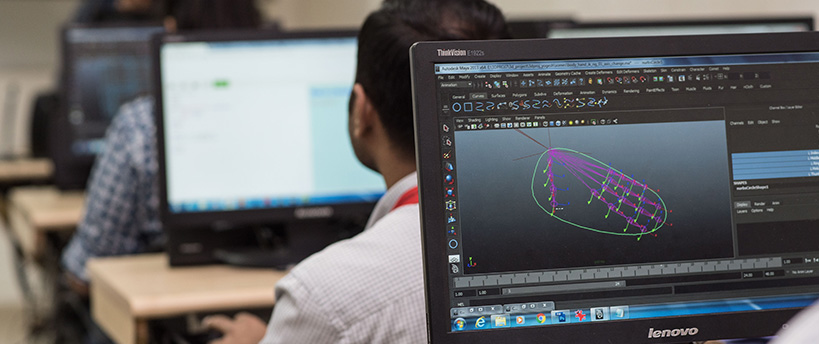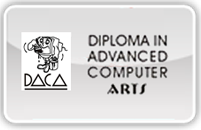

For admissions call +91 7208006694
C-DAC, ACTS has designed the following courses keeping in mind the emerging trends in advanced computing as well as contemporary and futuristic human resource requirements of the Computer / IT industry.
The advent of multimedia has had a profound impact on various media services such as advertising, film production, etc. In the present scenario, commercial artists who are familiar with computing technology have a wide range of opportunities in these market segments.
Computer Artists can offer consultancy services to architects, interior decorators for visualizing 3D architectures, textile industry, fashion designers, publishing industry, the education and training industry, tourism development, industrial design. They can also opt to provide visualization support to film-makers.

The internet and its diverse applications encompassing every field and aspect of life have created numerous opportunities for Web Page Designers. Besides Software Development Organizations, the Computer Animation Industry is in great need of Computer Artists. The unique Diploma in Advanced Computer Arts is undoubtedly a boon to the requirement of all these industries.
| Sr. No. | Module Name | Hours |
|---|---|---|
| 1. | Introduction to Computer Fundamentals | 30 |
| 2. |
Digital Image-editing and effects
|
150 |
| 3. |
2D Animation
|
180 |
| 4. | Project | 120 |
| Total | 480 |

Introduction to Computers, Power point presentation
Photoshop: Conventional & Computer Art and Image Editing Techniques, Introduction to Photoshop interface, Concept of Layers,Tools selection types, Image Collage Techniques, Concept of Masking (Types of Masking), Introduction to Scanner, Digital and Painting (Brush, digital Tablet), Retouching Images (Clone Stamp, Healing brush, Patch Tool), Pixel Art and Gift, Adjustment layer, Typography
Illustrator: Bitmap vs vector, Viewing/opening documents, Title bar info, New document specifications, RGB v CMYK, Navigation, Rulers, Guides and grids, Tool Panel: Tool bar, rawing simple shapes, Pen tool, Selections, Transforming shapes: Transforming shapes, Duplicating shapes & transformations, Type Tools: Selecting and creating type, Font usage, formatting, Type wrapping around objects, Converting to outlines, Object Relations: Basic fill, Basic strokes, Positioning, Alignment, Transparency, Saving and Exporting: Saving for various software imports, Bitmap vs vector export

Principles of animation
Squash and Stretch, Anticipation, Staging, Straight Ahead Action and Pose to Pose, Follow
Through and Overlapping Action, Slow In and Slow Out, Arc, Secondary Action, Timing, Exaggeration, Solid drawing, Appeal, Character
Development, Character Model sheet, Visualization of different views, How to Draw
Expressions, How to make Story-board, Story Board design, Camera visualization
After effect
Introduction to After Effects interface, Time line nonlinear
editing, Video editing (Includes correct video setting), Character Animation
(Rigging of character), Constrain of rigging, Typography Animation, Adding sound,
Trimming and editing Video, Colour Correction, Exporting Video output.
Digital Audio
Basic Qualities of Sound, Digitization of Sound, Sound
re-sampling, editing and mixing of WAV audio, Introduction to various File Formats
| Sr. No. | Module Name | Hours |
|---|---|---|
| 1. | UX process and Architecture | 80 |
| 2. | UI and Web Design and Development | 120 |
| 3. | 3D Game and Product Modelling | 160 |
| 4. | Project | 120 |
| Total | 480 |
Interviews: What is a User Interview?, How to conduct interviews as per Context, Collect data from different people as per context, https://www.interaction-design.org/literature/article/how-to-conduct-user-interviews, Observation: Interpretation of data which are collect in user interviews, Set focus and goals, https://www.interaction-design.org/literature/article/contextual-interviews-and-how-to-handle-them, Conceptual Model, User Model, Personas, Uses of personas in UX, https://www.interaction-design.org/literature/article/personas-why-and-how-you-should-use-them
Scenarios, Scenarios describe the stories and context behind why a specific user or user group comes to your site, https://www.usability.gov/how-to-and-tools/methods/scenarios.html
Wireframe, Prototype, Visual design, User testing

Basic HTML coding with Note Pad, Introduction to Dreamweaver user interface, Dreamweaver insert menu, Cascading style sheet, CSS3 properties, Dreamweaver spry Menu, Responsive, Javascript, jQuery, What is CMS?, What is prototypes?, Hybrid Development (Mobile + Web + Tablet), Design Thinking, AI, Chatbots, etc.

3D Max: Introduction to View ports and their navigation, Grouping, ungrouping and exploding, 2D spline Modeling, Modeling, Product Modeling, Modeling gazettes, Properties etc., Low poly modeling, Modeling for gaming, Material and Texturing, Using bump maps, noise and displacement, UVW unwrap, Texture Painting in Photoshop, Texture applying, Animation, Using track view controllers, Edit time, Keys and ranges, Animation constraints, Basic camera shots
| Sr. No. | Module Name | Hours |
|---|---|---|
| 1. | 3D Character animation with Maya | 220 |
| 2. | Digital Content | 80 |
| 3. | DACA Portfolio presentation | 60 |
| 4. | Project | 120 |
| Total | 480 |

Maya User Interface, 3D navigation and concepts, Modeling, Character Modeling, Material, Texturing, Lighting, Rigging and Skinning, Animation
Digital Media (Content), Motion Graphic, Online Advertisement ? (Flash, Adobe Edge, and Google Web Designer), Email Marketing ? (Photoshop, HTML, CSS), Landing Pages ? (Photoshop, HTML, CSS, Responsive, JS), Overview - How Digital Marketing works: Social Media, Content, Influencers, Remarketing
Interactive banners, Platform specific
3D Max: Introduction to View ports and their navigation, Grouping, ungrouping and exploding, 2D spline Modeling, Modeling, Product Modeling, Modeling gazettes, Properties etc., Low poly modeling, Modeling for gaming, Material and Texturing, Using bump maps, noise and displacement, UVW unwrap, Texture Painting in Photoshop, Texture applying, Animation, Using track view controllers, Edit time, Keys and ranges, Animation constraints, Basic camera shots
DACA course C-DAC web link: https://cdac.in/index.aspx?id=DACA&courseid=10
| S. No. | Activities | Dates | |
|---|---|---|---|
1. |
Start of online Registration and Application for DACA course |
May 16, 2024 |
|
2. |
Last date of Online Registration and Application of DACA course and Payment of registration fees |
June 15, 2024 |
|
3. |
Common Entrance Test CET 1 |
CET 1: June 22, 2024 |
|
4. |
Announcement of CET 1 Results |
June 26, 2024 |
|
5. |
Payment of First instalment of DACA course fees - Rs. 10,000/- plus GST (CET 1) |
July 06, 2024 |
|
6. |
Payment of Second instalment of DACA course fees - Rs. 90,000/- plus GST as applicable |
July 27, 2024 |
|
7. |
Commencement of DACA course |
Aug 19, 2024 |
|
| S. No. | Activities | Dates | |
|---|---|---|---|
1. |
Start of online Registration and Application for DACA course |
May 16, 2024 |
|
2. |
Last date of Online Registration and Application of DACA course and Payment of registration fees |
July 11, 2024 |
|
3. |
Common Entrance Test CET 2 |
CET 2: July 13, 2024 |
|
4. |
Announcement of CET 2 Results |
July 18 2024 |
|
5. |
Payment of First instalment of DACA course fees - Rs. 10,000/- plus GST (CET 2) |
July 28, 2024 |
|
6. |
Payment of Second instalment of DACA course fees - Rs. 90,000/- plus GST as applicable |
Aug 17, 2024 |
|
7. |
Commencement of DACA course |
Aug 19, 2024 |
|
For admissions call +91 7208006694